The Microloan Program is a U.S. Small Business Administration (SBA) initiative designed to provide small, short-term loans to start-ups, small businesses, and nonprofit childcare centers that need modest amounts of financing for various purposes. These loans help entrepreneurs and business owners who may not qualify for traditional bank loans. Here’s a detailed explanation of the Microloan Program:
Key Features and Components:
- Loan Amount: Microloans are relatively small, short-term loans, with a maximum loan amount of $50,000. The average microloan amount typically ranges from $13,000 to $15,000.
- Use of Funds: Microloans can be used for a variety of business purposes, including working capital, inventory, equipment, machinery, furniture, and fixtures. These loans are often used by start-ups and small businesses with modest financing needs.
- Terms and Interest Rates: The terms and interest rates for microloans vary depending on the intermediary lender and the specific loan agreement. However, the maximum term for an SBA Microloan is six years. Interest rates can range from around 6% to 13% or more, depending on the lender and the borrower’s creditworthiness.
- Intermediary Lenders: The SBA doesn’t directly provide microloans to borrowers. Instead, it works with nonprofit, community-based organizations known as intermediary lenders. These intermediaries receive funds from the SBA to provide microloans to small businesses and entrepreneurs within their communities.
- Loan Application Process: To apply for a microloan, small business owners and entrepreneurs should locate a local intermediary lender approved by the SBA. These organizations are typically found in various communities across the United States. The application process may include providing a business plan, personal financial information, and a description of how the funds will be used.
- Collateral and Personal Guarantee: Microloans may or may not require collateral, and the specific requirements can vary among intermediary lenders. Personal guarantees are often required.
- Credit Criteria: While the Microloan Program is more flexible than traditional bank loans, some credit criteria are still considered. However, borrowers with limited credit history or less-than-perfect credit may still qualify for microloans.
- Technical Assistance: Many intermediary lenders offer technical assistance and training to help borrowers with business planning, financial management, and other aspects of business ownership.
- Nonprofit Childcare Centers: In addition to small businesses, the Microloan Program provides loans to nonprofit childcare centers that need financing to improve or expand their facilities.
- Job Creation: Microloans are expected to help create or retain jobs in the local community. Small businesses receiving microloans are encouraged to demonstrate how the funds will contribute to job growth.
The Microloan Program plays a vital role in supporting entrepreneurs and small businesses, particularly those in underserved communities. It offers accessible financing solutions for start-ups and small enterprises with modest capital requirements. If you’re considering applying for a microloan or need guidance on how to leverage this program, please contact Obelisco Advisers experts. They can provide tailored advice and support to help you secure the right financing for your specific needs.






